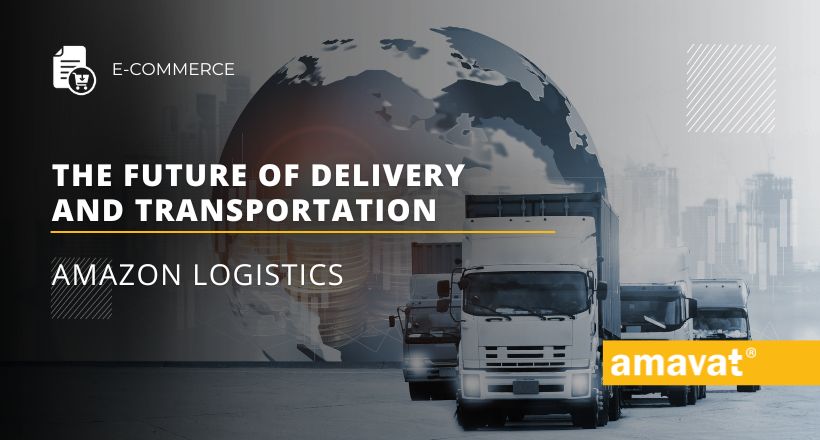Amazon warehouses: The future of delivery and transportation (Amazon Logistics)
Ordering on Amazon is simple – just one click and the package starts its journey to the customer. However, before the shipment appears at our doorstep, it must travel a long way. Order fulfillment is a multi-step process during which the package goes through several types of facilities in the logistics network. What exactly happens to it from the moment you click “buy” on the Amazon website until the courier delivers it to the specified address?
Amazon is one of the leaders in logistics and delivery, introducing innovative technologies and processes that are changing the future of e-commerce. In this article, we will look at Amazon’s logistics innovations, current operations, and forecasts for the future of delivery on Amazon.
Amazon’s logistics structure
Sorted product centers
Sorted product centers are places where Amazon employees handle orders for smaller items such as books, toys, clothes, or small household items. In these facilities, employees are supported by Amazon Robotics, which allows for faster order fulfillment. These facilities typically have about 80,000 square meters of space and employ over 1,500 workers.
Unsorted product centers
Unsorted product centers store and ship large items such as outdoor furniture, sports equipment, or carpets. These types of buildings have between 55,000 and 90,000 square meters of space and employ over 1,000 full-time workers.
Sorting centers
In sorting centers, employees sort orders by destination addresses and load them into trucks. A key element is the proper arrangement of packages, which facilitates quick unloading. Thanks to a well-developed infrastructure and shipping planning, Amazon customers can receive their orders daily – even on Sundays. Sorting centers employ full-time, temporary, and seasonal workers.
Receiving centers
Receiving centers handle orders for goods with seasonal demand spikes, such as during Christmas or Valentine’s Day. Sales data analysis allows for demand forecasting and ensuring adequate inventory levels. These centers usually occupy about 55,000 square meters of space.
Special products
Some facilities handle only specific categories of items. Employees in these centers often work part-time but have the opportunity to transition to full-time during periods of increased demand.
Delivery centers
Delivery centers are the final stage of order fulfillment – preparing the shipment for transport. Packages are shipped directly to consumers from here, often the next day after placing the order.
If you are interested in the locations of Amazon warehouses in Europe, we invite you to read our article: Selling on Amazon: Amazon warehouses in Europe in the context of VAT calculation.
Innovations in logistics – Amazon
Rivian electric delivery vehicles
Amazon uses Rivian electric delivery vehicles. These innovative cars are part of Amazon’s strategy to achieve net-zero carbon emissions by 2040. Electric vehicles provide exceptional working conditions, safety, and comfort for drivers. Amazon and Rivian engineers jointly designed these cars, considering both convenience and environmental care.
Emissions-free fleet
Amazon plans to invest over 1 billion euros in electrifying its European transportation network, reducing carbon emissions. In Germany, the company has already invested over 400 million euros, deploying over 1,000 electric delivery vehicles.
Prime Air drones
Amazon is testing and deploying drones for deliveries, which can now fly further and deliver packages to more customers after receiving FAA approval for beyond visual line of sight (BVLOS) operations. This technology allows Amazon Prime Air to operate drones on a larger scale, enabling faster and more efficient deliveries.
Driver support technologies
Amazon introduces various innovations to improve the delivery experience for drivers. Examples include Amazon smile lights – small, portable lights in the shape of the Amazon logo, increasing driver visibility. Additionally, driver and vehicle profiles in the Amazon app help customers more easily identify the delivery person.
Future forecasts
Amazon continuously develops its infrastructure and technologies to meet growing customer expectations. Investments in sustainable transportation, such as electric delivery vehicles and drones, will continue. The company plans to achieve net-zero carbon emissions by 2040, which means further investments in green technologies.
Global expansion
Amazon intends to expand its logistics operations into new markets to further increase its global presence. This includes building new logistics and delivery centers and developing a network of delivery partners.
Personalization and delivery speed
With advanced technologies like artificial intelligence and data analysis, Amazon will better predict customer needs and deliver orders even faster. Personalization of delivery services, such as more flexible delivery options, will become standard.
Sustainable development
Amazon will continue its efforts towards sustainable development, investing in renewable energy and technologies that reduce carbon emissions. Electrifying the transportation fleet and developing micromobility solutions, such as electric bikes, will be key elements of this strategy.
Summary
Amazon Logistics exemplifies how modern technologies can transform the face of logistics and delivery. With innovations such as Rivian electric delivery vehicles, Prime Air drones, and advanced driver support technologies, Amazon continuously raises standards in the e-commerce industry. The future of delivery on Amazon looks bright, with a focus on speed, efficiency, and sustainability, which will undoubtedly benefit both customers and e-commerce sellers.





